How Are Diamonds Made? Natural vs Lab-Created Explained
Two Paths, One Diamond Not all diamonds come from the same place — but they all start the same way. Pure carbon, crystalized under immense pressure and heat. Whether it…
My wife Drena left a week before me (with Vanessa) and visited some of our joint suppliers in ArezzoItaly, 100km south of Florence. Most unfair that she gets to go and that it seems I will not visit Europe this year; Italy is my favorite place to be, but they did some buying for me, so cant complain too much. I arrived in Vegas a day before on the morning of Tuesday the 31st May and visited Jim Caudill the head of the American Gem Society’s (AGS) new Advanced Instruments Division (AGS.AID). We had just managed to ‘facilitate’ the manufacture of their new hand held ASET scope in time for it to be released at the Vegas show – the biggest jewel trade fair in the world.


Drena and Vanessa in Italy, and the view from my Vegas hotel window – the Sands convention is the low white building in the center foreground. Distance is deceptive in the desert; the Sands is a huge multi storey building.
On the first evening I had dinner with my friend Don Greig who developed the stock management software we have used in our 2 stores since 1985. Don lives in Vegas now and has hundreds of retail jewelers on his Focus Management system.


The next day various other people began turning up. First was Dave Atlas, who runs a lab in Philadelphia (more later) and is the US agent for ideal-scope. Dave is on the far right at a suburban Japanese restaurant with Paul and Lieve to his right. Paul and Lieve have been wonderful hosts a couple of times in Antwerp Belgium, where they run a boutique cutting business, specializing in ideal cut rounds and princess. On the far left is the affable Web trader, Wink Jones from Boise Idaho.




This group of 5 images shows the excesses of Vegas; the Venetian Hotel. The sky is painted on the ceiling. SAN Marco square has regular performances of frozen people statues and singers etc while the Gondalos cruise up and down the store lined canals. The multi colored thing is an oxygen bar where you pay to breathe pure oxygen.

Next day the seminars began. One of the first presentations was by my good friend Leonid Tcharnyi, founder of Pricescope. The crowd shot was taken 10 minutes before the presentation, the room filled to over flowing and people were turned away. Leonid explained to the rather antagonistic gathering of mainly retailers how and why they should not treat the Internet as just another form of advertising and marketing. Leonid is fast becoming a recognized ‘Social Computing’ Guru after having established the worlds leading diamond and jewellery chat forums with my diamond tutorials.
Unfortunately Leonid’s presentation clashed with that of Peter Yantzer at the AGS about their new diamond cut grading system. However we had been invited to a private presentation later that day at the AGS rooms ? an hour off ‘the strip’.
AGS is a not for profit trade .org of jewelers and suppliers committed to ethics and educational standards. They also run a respected independent diamond grading lab, half owned by the not for profit and a group of investor members –Peter Yantzer is its CEO. I first met Peter at the Vegas fair in 1999, at the start of my global crusade to improve the cut quality of diamonds. I took an adversarial position with Peter; I did not like their grading system that included some so-so looking so called ‘Ideal Cuts’. At that time my new Russian friends & I were lonely voices. Peter was amazingly patient with me, he agreed that their system was not ‘ideal’ (pun) and that as soon as he could develop a better system he would. I am pleased to say that the system they launched in Vegas does now guarantee a superior diamond. I am flattered that the system was developed with the same process steps that I used to develop HCA (the Holloway Cut Adviser).
AGS used my Russian associates ray tracing and diamond modeling software DiamCalc™ to generate Angular Spectrum Analysis Tool (ASET) images which they produced in sets in grids to identify the optimum proportions for round and princess cut diamonds. Then they did analysis of those proportion sets with ray tracing software like DiamCalc that they developed, but all the images for the charts are from DiamCalc; their in house ray tracing software does not produce good detailed images.
ASET comes in 2 forms, the desk top seen here with the DiamCalc charts of ASET images on the left, and the hand held that I had a hand in, in the central photo. The 2 stones shown here are a poorly cut and well cut stone that I snapped with my little Canon thru the hand held scope.




That night we (Drena, Vanessa and I, with Leonid) ate at the swank Bellagio’s Japanese restaurant with Udi from Israel; he runs a B2B diamond web portal that lists a good % of the worlds polished diamonds. The bar area of the restaurant has 3 fish tanks with UV fluorescent Jelly Fish flapping about – really cool.



After dinner we sat on the balcony watching the enormous water canon fountains that dance to music, with the 1/3rd scale Eiffel Tower in the distance across the strip.


Here are a couple of shots in a bar with some notorious dudes, John and Jonathon (‘my camera’s bigger’an yours’) and Lieve’s unbelievable vivid yellow Rock that really is ‘unbelievable’.
The next 5 shots were taken in the old original Vegas area before the action moved a few miles away to ‘the strip’. The group shot from left to right: Vanessa, Deborah (Peter’s fiancee), (Drena hiding), Lieve, Paul, Moi and Peter Y. After dinner we went ‘outside’ into a covered Mall, about 500 yards long. The ceiling was an LED array that very ? hour has a ‘show’. We saw racing cars dragging up and down the ‘strip’ with crowds either side – it was quite amazing.





Next morning was the iconic Martin Rapaport breakfast show. Every year I have heard Martin present once or twice for the past 8 years. In 1999 & 2000, he was instrumental in my becoming involved in the world of the Internet.

The next few paragraphs will be a summary of the presentation; skip it if you like.
After the Vegas trade show Vanessa flew home and Drena and I went on vacation to Washington, Philadelphia and NYC. At the show I was introduced by Paul’s to one of his new stockists who said “if you ever come to Washington let me know” I said we will be there next week. Well Bill organized a tour of a senate office and the Capitol building and the Smithsonian Gem and Mineral collection.






From the Top left, the Library of Congress, The Capitol building from the front of the Russel Senate building and a stair case inside it. We went on one of the underground tram / trains you see on the movies from the senate building to the Capitol, a Senator joined us on the way there. To be a US senator you must be more than 6 foot 3.



The amazing thing is just how accessible all this area is to the general public. We were able to enter and sit for as long as we liked in the Senate – Teddy Kennedy was rambling on about all sorts of injustices, but it seems the senators do not need to be present for each others presentations- only for voting etc – so Teddy was talking to himself. He would make a great auctioneer. Our guide Kate had graduated a few months before in political science and law and was on a 4 month sucondment. She had written a couple of papers that her boss, Senator Gordon Smith from Oregon Washington State had presented. The statue of an Hawaiian King is bronze and solid gold, it weighs so much they could not put it out in the main dome hall where all the other State statues were; it had to be near the wall over a pillar on the floor below.



That afternoon we went to the Zoo, which was about a mile from our hotel (apparently the Wardman Towers hotel was once Senators lodgings and part of Watergate was played out there.) It was very hot and humid that day, and maybe we did not get the right feel for the zoo, but we found a lot of the cells were very small and a lot of the zoo was depressing.
Smithsonian



Next morning Bill picked us up and we drove around town for a while before our meeting with a Curator at the Smithsonian. We happened upon a truck in the No-Truck-Go-Zone. Nothing big enough to carry a lot of explosives is allowed in close proximity to critical Govt buildings; this truck is right over the top of the tunnel we went through connecting the Russell Senate building and Capitol building. There were quite a few angry gun toting police and security guards and cars surrounding the truck. We parked a block away from the White House and took this shot of Drena and Bill out front. The third photo, off to the left of the other, is where the press have semi permanent camera and lighting set-ups. When we see news reports with a journalist being interviewed with the White House in the background, this is where it is filmed.



Pictured above is Russell C Feather, II, Collection Manager/Gemologist at the Smithsonian Museum of Natural History. Almost every public gallery and place in Washington is part of the Smithsonian, but the next photo is probably the most famous of the entire collection. And we were amazed at how close and how accessible this most famous (infamous) diamond was. The only thing we would have liked in addition would have to had the option to see it under UV light (It turns bright red). Russell took us into the back rooms and the strong room where all the valuable off display collection is housed. There would easily be 5 times more there than on display at any one time.





We were lucky to get up very close to the aurora collection, shown here in flash and closer in normal light. An early 18th Century Trembler Tiara shows the brass coils that allow the diamond flowers to vibrate and move.







Below are a few shots from the display. The huge faceted calcite showed how dispersion colors can get a muddy appearance when a beam is split into two dispersed rays that mix. The Pyrite cubes were amazing, and the Asscher cut ‘Portuguese diamond’ has such strong fluorescence that it is clearly visible in any lighting.
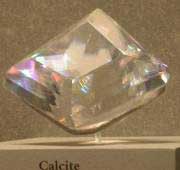




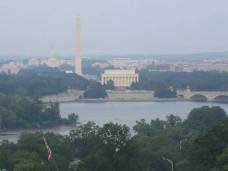


These 3 perspective shots show the main monuments that all line up. The first shot taken from the other side of the Potomac River shows the Lincoln Memorial in front of the ??? and Capitol house in the background. This was taken from Bill’s apartment where we were introduced to his Aussie Lawyer wife and new born daughter before heading out for a bite to eat. The other 2 were taken the next day when my cousin Louise and Fiancee Carl joined us for Sat and Sunday. They are both stem cell researchers in Boston. On the Saturday we went to the Air and Space Museum.




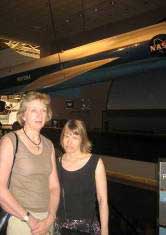


As you can see Drena and Louise found everything from the Wright Bros. plane to new space stations and landing craft very exciting. Carl and I think they may have nodded off in the Planetarium. After a quick visit to the Native American Museum however, we found the Botanic Garden Glass House and Drena’s spirits improved.

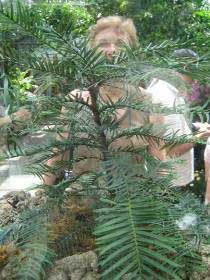
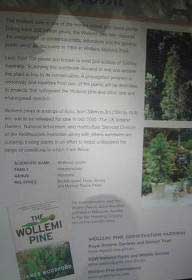
There was even a rare & endangered species of Aussie flora – an ancient Wollemi pine in a very protective glass case.

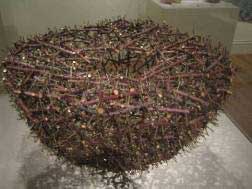
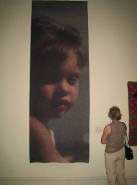


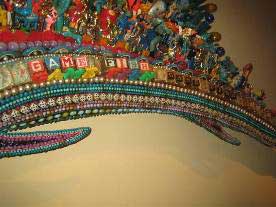

Carl and Lou wanted to se the White House, and nearby I had been intrigued by this Dresden style red brick Victorian building. It was an art gallery with a special exhibition of ‘fibre’ based arts and crafts that blew us away. A bowl made od sticks pinned together, a tapestry that looks from a distance like a photo printed on paper – see inset close-up. A ‘game fish’ made of board game bits and pieces and finally a grandfather clock that was carved out of a solid piece of timber and what appears to be a white canvas cover is actually bleached timber – it looked so real that even after reading the note, it was hard to believe. There was also a big ballroom with some a range of period US art that reminded us of two of our favorites – Bendigo and Ballart art galleries.
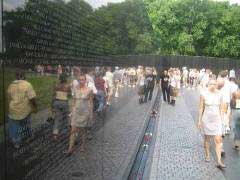


Above is the Vietnam War Memorial – about 500 yards of polished black granite wall with the names of every soldier killed or missing in action. Very poignant. A statue of 3 fit healthy and aggressive soldiers apparently led to pressure to show the worst side of war; two female nurses are seen here caring for a wounded soldier.






After Carl and Louise flew home Drena finally got her way and we went to the Arbitorium, which was off all the maps we had. Actually it was just a subway and a short taxi ride. But of course we pronounce the word just like Auditorium – and they call it something quite different, but somehow the taxi driver worked it out. This was a huge National Botanic parkland that is like a living museum of trees. We did a guided tour on an open tram, which was great because it was very hot and as humid as I have ever experienced; Darwin in November.
The first pic shows a garden with a replica of an ancient Greek temple ruin in the upper left. The under the tree photo is actually under a 2 foot high Bonsai.
Next day we caught the train to Philadelphia. Countryside was mostly light industrial outer suburban and not that interesting. Next day we hired a car and drove a couple of hours to the Amish area near Lancaster. The Amish are an extremist offshoot of the Mennonites who believe that politics and religion should never be mixed. A lot of them emigrated from Protestant Northern Germany / Flemish regions during the 18th century when Penn (as in Pennsylvania) promised them freedom of beliefs. The area has a lot of Mennonites too, who seem to be a little more like the Jehovah Witness. The Amish do not hook up to the electricity grid, have no mechanized conveyances like push bikes, but scooters and roller blades (the girl in the foreground) and billy carts are OK. The men have Abraham Lincoln beards (no moustache) and the women wear plain long dresses with their hair tied up in little gauze bonnets. The women with the pusher was at one of the 2 huge discount outlet centers where they have space for horse and carts to be tied up.
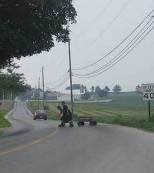




There is plenty of commerce going on between the Amish and normal folk / tourists.

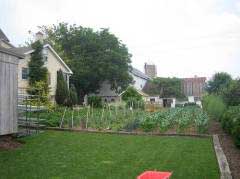

We drove up to this farm house where they were selling very nice root beer (sarsaparilla), jams and strawberries. There was a single cylinder put-put motor driving some machinery in one of the sheds – it seems motors are OK, as long as they are not for moving you around. In the scene below where a horse drawn mower is cutting hay, the cutters are driven by a put-put motor.





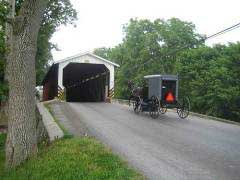
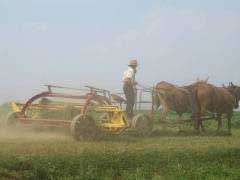
Back in Philly we found a couple of great Jazz bars. On Tuesday ‘students’ night jamming was on the schedule. The 2 ladies both did solo acts, and as we were leaving we chatted with them. The one on the left’s surname was Parton, and on the right Holiday. Naturally I asked if they were relatives of the more famous namesakes. Both were pretty quick; Ms Parton said she was Wendy Huston’s sister and Ms Holiday explained that Billy Holiday was a stage name. The Philly Town Hall is beautiful by day and by night.

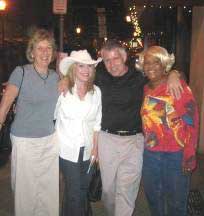
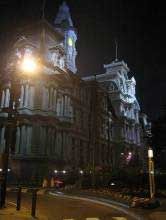

Now for a little history and economics lesson. See the little plaque on the upper right under the eves of this 200 year old house. It is the sign that the property had paid its fire insurance levy established by famous local Benjamin Franklin. IT seems Ben established the first ever firebrigade – but to have them save your house you had to pay the insurance levy. No pay and they just watched your house burn down. Now would this be an incentive to set fire to non paying customers houses and businesses? Is this were the whole US gangster and protection rackets sprung from? Who knows?


Drena and I visited Dave Atlas’ lab in Philadelphia. I first made contact with Dave around the late 1980’s when I asked permission to use his fancy cut grading charts in lectures at the Aussie GAA diamond course. Dave has done a lot of work with ImaGem and the next photo shows from the left, Dave Atlas with Prof. Lalit Aggarwal and me to the right in the AGA back room with the ImaGem large machine behind Dave and Prof A, with the small Clarity immersion machine behind me.

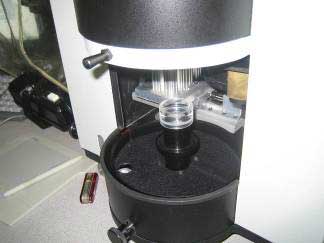


These next 4 photo’s show the stone being placed table down in the clarity machine in a small plastic dish filled with “liquid 2” which is a proprietary liquid that reduces the RI of the diamond so that a better photo of the inclusions can be captured. Note in a black lighting dome has dropped down to cover the stone; the hole in the top is for the camera view.
From this bottom view the software ‘flips’ the stone so the inclusion plot is able to be shown table up. This operation requires an expert operator which will somewhat slow down what was originally designed as a semi automated process.
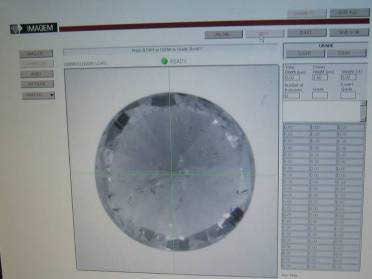
This first shot shows the captured. Next the red inclusion maps appear over the photo. The outer dark regions were reflection patterns that the operator discounted completely by clicking and dragging the sensitivity for both the table or the outer crown area independently. Lowering this sensitivity missed some inclusions – but the operator mouse clicked individual smaller inclusions which were automatically highlighted in red. The intention of the system is to grade VS2 to SI3 stones and automatically develop inclusion plots from the front side. Higher level inclusions (Flawless to VVS) could be done too (I was told) but this requires a number of photo’s to be taken to cover the stone depth of field.

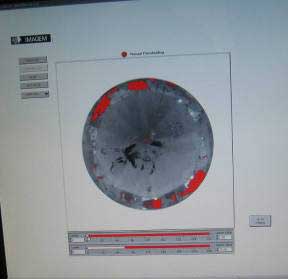



The operator then pressed a key and the system calculated the frontal view. But this plot would be a sale killer on an SI3 / I1 stone, so they developed a representative system that uses accepted signs. If you follow the progress in the images below you will see the two large inclusions have been highlighted blue, and from a drop down menu they have been turned into (in this case) Internal fractures which are represented only by pairs of parallel lines. The table up plot (and the pavilion up if required) can then be printed in any format from credit card to full report.



Next we moved from the clarity system to the main system, the big central box and screen to the left.
The little grey door in the upper left side, above the white Logo square, hinges open and the stone is placed inside, table down on a glass tray.

A little lever with a tiny cup is lowered over the culet to center the diamond.
The first screen shot has the stone depth and known weight (and polish) entered into the scanner manually. This I believe is done to increase the scan accuracy; but Prof A is insistent that it is one of many fail safe processes to ensure the system accuracy. The slide is out of focus, but the two red bits of data are the manually entered depth and the weight. The data I gave was a guess as the 2 stones we ran, they are the good and bad CZ’s we sell on the www.Ideal-scope.com (I ran the same 2 stones in Vegas and this caused some ‘anomalous’ results because the bad stone scored extremely well on the measure of ‘intensity’. Prof A assured me the machine had not been properly adjusted before it left for Vegas).
The depth of the stone shows a tiny red warning flag you will see on later clearer slides. This is set with a tolerance from the measured difference – 0.002mm I think. Note the bar in the upper left indicates the machine is working. I am told the processing time is a few minutes and one machine can process 2,500 stones a month, with 1 operator operating 4 machines. I assume booking in staff, gemologist for polish analysis, report printing and laminating and clarity plotting are in addition.


You can also see in the fuzzy photo above there is a little image in the upper left of the diamonds table shown in reflected light. Many little images flashed on the screen while the machine made little whirring noises; the image is out of focus because I only had a second to take the photo. Prof A told me the system measures the position of each corner of the table from this reflected light image (there are little red X’s on the corner positions). This gives them the ability to measure more accurately.
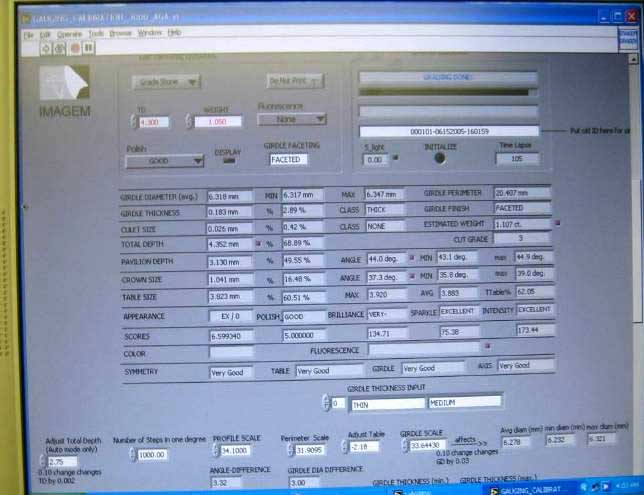
Now we can see the completed screen. Firstly note the little red warning flag beside the depth.
But the results for this poorly cut, but symmetrical nail head CZ were perhaps also like that in Vegas.
| Poor – Range – Excellent | Bad CZ | Good CZ | ||
| Brilliance | <80 | >150 | 134.71 | 149.21 |
| Sparkle | <5 | >70 | 75.38 | 82.89 |
| Intensity | 100-105 | >160 | 173.44 | 110.22 |
Explanations were offered, but I did not want to waste a lot of time. There were little warnings that this stone may have been outside the ‘normal range’ as it had little red flags on crown and pavilion angles. We moved on.
Below is the scan for the good CZ stone. In fairness I should say that both ISee2 and the BrillianceScope give similar undifferentiated and excellent scores for these 2 stones.

The light reading is said to be done from different zones or regions. http://www.imageminc.com/products/VerigemInstrument.html
Prof A would not describe the lighting environment, but both he a Dave maintain it is a very reasonable environment. They claim however that the light will not favor symmetrical stones the way ISEE2 and BrillianceScope do with their respective rotating bar light and circular ring light.
I was impressed that axial symmetry, which is the average of all axes, has been included as per this article.
Prof A said the gauging or scanning system has a high level of accuracy. I asked if they can produce .stl files as part of the grading service so users could have more accurate 3D files for use with say the AGS grading system. He said they had no plans and could not imagine why they should and implied they would not help another lab. The scan is said to be + – 5 microns gauging accuracy.
That evening we went to Dave’s for dinner.



Here is Dave holding his 2 great loves, Diane on the left and in the center his MV Augusta Brutale

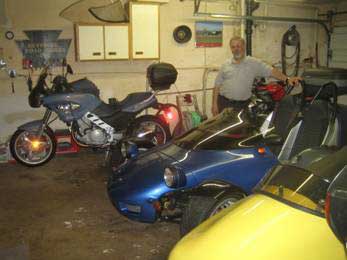
They live in a lovely quiet suburban area about 40 minutes drive from downtown. The house has a lovely outlook to a pool side Cabana with well stocked fridge :). Dave often rides one of his ‘harem’ into work; they are mostly BMW variants, including the blue 3 wheeler. Diane said to me (quietly on the side) “Some men play around on the side, but the bikes are his passion”. Dave is probably the most genuine guy you will ever meet. No pretence, no games or politics, just plain speaking and very polite. We enjoyed a lovely pool side BBQ and balmy evening.
Next we trained it to NYC. Below is Cydonia and Barry in their 30th floor apartment – we met on the Place on Wheels in Feb 2005. The closest we came to the Museum of Modern Art (across the road from the hotel) was seeing this truck load of sculpture being unloaded. Of more interest to us was the Frick Museum, a turn of century mansion art gallery.


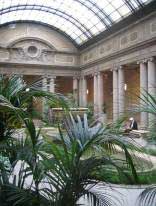



The Metropolitan Museum is one of our favorites, and they had numbered exhibits with talking handsets. On Sunday morning we went to a Broadway jazz club for Gospel singing. They were fab – one of the trips highlights, that evening we went to the Rock Church for what we thought would be more of the same. How wrong were we? It was a regular Pentecostal type church with a Pommie Chaplan with an out of tune guitar and a flat voice. There was a fair bit of hallelujah style weeping and wailing too. Not quite what little Metho-Presbuttons like Drena and Garry grew up with. We could hardly leave mid service though, as there were only about a dozen parishner’s and they were acutely aware of making us more than welcome by passing bibles and hymn books to us throughout the service.
I was very good at taking my vacation in NYC. Apart from several phone calls, one Jazz club dinner and a bit of shopping for some tools for Stella, there was no other work done. But had to take these few photo’s. The first 2 are Harry Winston windows. The peep hole on the right has a 10ct oval diamond ring in it (with a dreadful bowtie). De Beers are opening a new 5th Ave store soon; just had to get the incongruous US flag into the pic. The US Govt has had a warrant for the arrest of De Beers exec’s since the 1960’s for monopolistic behaviour until very recently when De Beers paid out and settled some long standing cases.






This shop in fashionable Soho is Teno, a German brand of Stainless Steel that we have had in stock for the last couple of years. Drena had a fascination for the external fire-escapes – this building had 3. And finally Drena and Garry sharing one of the very inexpensive and healthy meals that one can self select from the many NY salad bars. All up less than $20, complete with quite nice light Italian red in plastic cups.
This article is part 3 of a 3 part series. Other articles in this series are shown below:

Retail Diamond Prices Chart Updated Monthly.
Two Paths, One Diamond Not all diamonds come from the same place — but they all start the same way. Pure carbon, crystalized under immense pressure and heat. Whether it…
A Wedding Ring as Unique as Your Love Finding the right wedding ring isn’t just about diamonds or gold – it’s about finding the one that feels right. With hundreds…
So, you’re thinking about lab-grown diamonds? Smart move. They’re just as sparkly as the natural kind but usually cost less. But where do you actually go to buy them? It…


Want to stay updated on the most recent blogs, forum posts, and educational articles? Sign up for Bling News, PriceScope’s weekly newsletter.